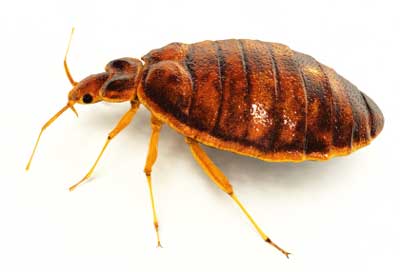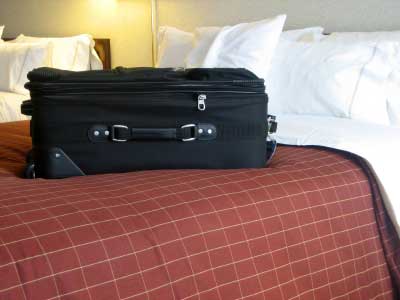Can Bedbugs Feed in My Dog
 Bed bugs seem to be back with a vengeance! Many developed countries, including the U.S., where the bugs seemed for years to have been a thing of the past, are now having to contend with them once more. Although bed bugs have been unwelcome companions of people since ancient times, as their numbers dropped drastically in the 1940s and '50s (due in large part to the use of synthetic insecticides such as DDT and improvements in hygiene), so did American's knowledge and vigilance regarding these pests. This fact, along with increased domestic and international travel, increased insecticide resistance in the bugs, increased transfer/re-use of used furniture, and increased "clutter" and belongings in our homes, have set up a perfect scenario for resurgence of these bugs. Once in our homes, these pests are hard and expensive to control and eradicate. Thus, preventing their introduction into your home is increasingly important.
Bed bugs seem to be back with a vengeance! Many developed countries, including the U.S., where the bugs seemed for years to have been a thing of the past, are now having to contend with them once more. Although bed bugs have been unwelcome companions of people since ancient times, as their numbers dropped drastically in the 1940s and '50s (due in large part to the use of synthetic insecticides such as DDT and improvements in hygiene), so did American's knowledge and vigilance regarding these pests. This fact, along with increased domestic and international travel, increased insecticide resistance in the bugs, increased transfer/re-use of used furniture, and increased "clutter" and belongings in our homes, have set up a perfect scenario for resurgence of these bugs. Once in our homes, these pests are hard and expensive to control and eradicate. Thus, preventing their introduction into your home is increasingly important.
So, what exactly are bed bugs?
Bed bugs are insects in the family Cimicidae. Two species are associated with humans (others are parasites of birds, bats and other mammals): Cimex lectularius is present worldwide, while Cimex hemipterus is a tropical bug. These are small (1-7 mm) brownish-red, flattened, wingless, blood-feeding insects; adults are about the size of a grain of rice. They have 6 legs and 2 long antennae made up of 4 segments. Bed bugs, as the name implies, are present mainly in areas where people and animals sleep. They are active at night (peak activity is usually between midnight and 6 am) when they feed on sleeping people and animals. Females lay eggs in cracks and crevices (e.g. head boards, box springs, bed frames, mattress seams, furniture joints, baseboard cracks, etc.), places where bed bugs routinely hide while not feeding. These eggs hatch into nymphs, which are miniature replicas of the adults. After 5 generations of nymphs, adults develop. Adults then mate and produce more eggs. All stages of bed bugs (excluding eggs, of course), feed on blood typically every 8-10 days, but they can go months without a meal.
Why are bed bugs important?
As mentioned above, these bugs must feed on blood, and will feed on humans as well as cats and dogs. Fortunately, bed bugs have not been shown to transmit any diseases; however, their bites can cause anemia (especially in children), pruritus (itchiness), allergic reactions, discomfort, sleeplessness, and stress. In addition, they can be very hard to control or eradicate (especially in multi-family homes and buildings), leading sometimes to great monetary expense. In addition, because bed bug infestations may require at least some insecticide use, their presence increases exposure of people and animals to pesticides; it is of utmost importance that these chemicals, if used, be used only as specified on their labels to reduce the risk of health problems from these potentially toxic compounds.
How do bed bugs get into a home or building?
Bed bugs are great hitch-hikers and expert hiders. Due to their small size, they can hide away and be transported into a home through "passive transport", that is: they simply hitch a ride in furniture seams, mattress  folds, seams in luggage, folded clothes, bedding, etc. In multi-family or multi-occupancy homes and buildings (e.g. apartment buildings, hotels, shelters, rooming houses, cruise ships) bed bugs can also move actively between rooms (i.e. they can literally walk from one room to another). Bed bugs are closely associated with people and our belongings. Although bugs can sometimes be found on cats and dogs, this situation is unusual; it is not likely that cats and dogs will introduce a bed bug infestation into a home because any bugs that crawled onto them to feed during the night generally would have gone into hiding during the day. So, it is more likely the bugs are stowed away in your luggage than on your cat or dog (or on you, for that matter).
folds, seams in luggage, folded clothes, bedding, etc. In multi-family or multi-occupancy homes and buildings (e.g. apartment buildings, hotels, shelters, rooming houses, cruise ships) bed bugs can also move actively between rooms (i.e. they can literally walk from one room to another). Bed bugs are closely associated with people and our belongings. Although bugs can sometimes be found on cats and dogs, this situation is unusual; it is not likely that cats and dogs will introduce a bed bug infestation into a home because any bugs that crawled onto them to feed during the night generally would have gone into hiding during the day. So, it is more likely the bugs are stowed away in your luggage than on your cat or dog (or on you, for that matter).
Will bed bugs bite cats and dogs?
Yes, in addition to biting and feeding on people, bedbugs are known to feed on cats and dogs in infested homes.
How do you know if you have an infestation?
There are several clues or signs that can help identify infestations. In rare reports, people have observed bed bugs crawling on themselves, or their pets. However, as mentioned above, this is unusual. More likely, are the telltale signs of small insect bites anywhere on the body; these may resemble those of other biting insects (mosquitos or fleas), so it is important to look for other signs. Like other insects, bed bugs must shed their exoskeletons in order to grow, so finding these "molts" can help identify an infestation, as well as finding actual bed bugs in the folds of the mattress or trapped in the sheets. In addition, bed bug feces may leave rusty spots on bedding or nearby furniture and bugs are said to give a sweet, musty odor to areas in which they are present. Additionally, a number of commercial bed bug traps and monitors are now available, and bed bug detecting dogs can sniff out infestations.
What can you do if you believe you have bedbugs in your home?
If you believe there are already bedbugs in your home, try to collect a sample for an expert to identify, and contact your landlord or a pest control company that has experience with bed bug control. Controlling and eradicating bed bugs is a process that will take time and patience. The Centers for Disease Control and Prevention, in conjunction with the U. S. Environmental Protection Agency, have put together a joint statement on bedbug control, which includes non-chemical as well as chemical measures for control - statement . Frequent vacuuming and laundering (including drying in high heat), reduction of clutter, and sealing cracks and crevices can help reduce the number of bugs. Use of diatomaceous earth may also be helpful in this regard. If the infestation is not heavy, these measures alone could eventually eradicate the infestation. However, in certain situations, use of effective and approved pesticides by professionals may be needed. Remember, if a product does not have a U.S. EPA registration number, it has not been reviewed by the EPA and its safety and efficacy against bed bugs is not known. In addition, any pesticide to be used against bed bugs should have these bugs explicitly listed on the label, otherwise it is unknown if the product would be of any use against them.
Can pet anti-tick and anti-flea products keep bed bugs away?
Anti-tick and anti-flea pet products are just that: tick and flea products. They were not developed to protect pets against bed bugs and would be expected to have little or no effect on an infestation.
How can I protect my pets from a bed bug infestation?
Bed bugs do not live on animals the way fleas do. They are hidden in the environment and come out only at night to feed. Thus, it is unusual for pets to carry bugs on them. Protecting pets from bed bugs is achieved by default as you protect yourself and your home from bed bugs: through vigilance and hygiene. If you already have an infestation at home, eradicating that infestation will keep your entire family (including your pets) protected from the nuisance of bed bugs. When travelling (with or without your pet), check areas around the bed (head board and box spring, especially) for bed bugs or signs of bed bug infestation. Remember that these bugs are visible to the naked eye, although they are small. Keep luggage, pet crates and pet bedding away from the bed, if possible (consider storing them in the bathroom or a space away from sleeping areas and couches). When leaving your hotel, inspect all luggage, pet crates and pet bedding carefully to try to ensure no hidden bugs will be travelling home with you. Consider having your pet bathed and groomed before bringing them home (this may remove any bugs from the animal if they happen to be present), and visually inspect your pet for bed bugs. Luggage, pet carriers, and bedding can be left in the car for about 1-2 weeks after you return home. In areas of the country with extreme weather (hot and cold) this can further reduce the number of live bed bugs by heat-killing or freezing them. When you do bring these belongings into your home, launder everything immediately (clothing, pet bedding, etc.) being sure to use hot water and/or the dryer on medium-high heat; washing alone will not kill bed bugs, but high-heat drying will. There is no fail-safe way to ensure that you, your belongings or your pet will not bring unwanted guests home, but these measures can help reduce the risk.
By Araceli Lucio-Forster, PhD.
Teaching Support Specialist, Department of Microbiology and Immunology
College of Veterinary Medicine, Cornell University
Source: https://www.petsandparasites.org/parasites-and-your-family/bed-bugs-theyre-ba-aack#:~:text=Yes%2C%20in%20addition%20to%20biting,and%20dogs%20in%20infested%20homes.
0 Response to "Can Bedbugs Feed in My Dog"
Post a Comment